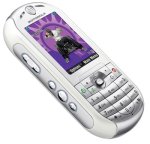Mot taps Linux for next-gen music phone
Jan 3, 2006 — by LinuxDevices Staff — from the LinuxDevices Archive — 3 views [Updated Jan. 5] — Motorola will base its second-generation music phone for US customers on Linux, along with USB 2.0, a normal (non-iTunes) mp3 player, built-in FM radio, and SD card storage. The company will demonstrate its Rokr E2 at the Consumer Electronics Show (CES) in Las Vegas this week.
[Updated Jan. 5] — Motorola will base its second-generation music phone for US customers on Linux, along with USB 2.0, a normal (non-iTunes) mp3 player, built-in FM radio, and SD card storage. The company will demonstrate its Rokr E2 at the Consumer Electronics Show (CES) in Las Vegas this week.
(Click for larger view of Rokr E2 mockup)
Motorola originally announced plans to transition most of its mobile phones to Linux on Valentines Day, 2003, and the company has subsequently brought out a variety of relatively high-end mobile phones based on Linux. The company describes the E2 as its first “mid-market” Linux phone, and says the device “further demonstrates Motorola's commitment to driving Linux-for-mobile innovation across the company's device portfolio.”
Motorola has used MontaVista Linux in its previous Linux-based mobile designs. MontaVista's newest mobile phone OS, Mobilinux, is positioned as a versatile product capable of powering products in both mid-range and high-end market niches, allowing customers to standardize on a single mobile phone OS technology.
Motorola's first-generation Rokr phone was not based on Linux, and received a lukewarm reception despite a high-profile launch effort by Steve Jobs at a recent Macworld event. Mobile news sources have reported trouble between Apple and Motorola related to pricing, revenue distribution, and an artificial 100-song limit imposed by Apple.
 Motorola has previously used Linux in its music phones for the enormous Asian market, including the E680 and E680i (pictured at right).
Motorola has previously used Linux in its music phones for the enormous Asian market, including the E680 and E680i (pictured at right).
Other Motorola mobile phones, such as the V3i, may continue to support iTunes.
 |
in black (Click to enlarge) |
The Rokr E2
Like the original Rokr E1, the E2 is expected to be a GSM phone, meaning it will likely be available for use with US carrier Cingular's wireless network.
In its announcement today, Motorola said that Linux will enhance the speed and flexibility of the Rokr E2. The device will come with an media player supporting video as well as a number a variety of audio formats (though not iTunes). With an optional 2GB SD memory expansion card, the E2 will store about 500 songs.
The E2 is also likely to benefit from recent interface improvements aimed at engendering a familiar feel for replacement customers moving to Motorola from other brands.
 |
player controls (Click to enlarge) |
Additional claimed features include:
- 2 inch, 240 x 320 TFT (262k colors)
- Fast data transfers based on “drag-and-drop” USB 2.0 PC networking
- Dedicated side-mounted hardware music-player keys (shown at right)
- Built-in FM radio
- Support for Motorola's new iRadio service
- Support for Bluetooth- and 3.5mm jack-based headsets
- 1.3-megapixel camera
- 15 fps video capture and playback
- MMS (multimedia messaging service) client
- Opera browser
- Unique “airplane mode” claimed to allow safe listening onboard airplanes
- PIM (personal information manager) with picture caller ID
- “Screen3” technology for “zero-click access to news, sports, entertainment, and other premium content”
Richard Chin, corporate VP of global mobile device marketing, stated, “Consumers want their music with them, wherever they go. Motorola is driving the convergence of music and mobility by combining the device you never leave home without, with the entertainment consumers crave.”
Availability
The Motorola Rokr E2 is expected to be available in the first half of 2006, priced between $200 and $250 with a two-year contract. Its radio technologies and carriers have not yet been announced. Further details will be announced upon consumer availability, the company says.
The Rokr E2 could well be the first Linux mobile phone to achieve widespread US distribution, pending carrier buy-in.
For additional details, be sure to read PC Magazine's coverage by clicking the link below. Engadget has also published a video preview of the E2 phone, here.
This article was originally published on LinuxDevices.com and has been donated to the open source community by QuinStreet Inc. Please visit LinuxToday.com for up-to-date news and articles about Linux and open source.